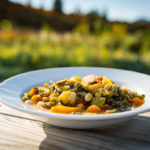Spend a few hours preparing this soup and you'll reap the benefits for days (or even months) to come - the flavor only gets better over time.
This recipe is part of the Just Picked series, a partnership between Modern Farmer + Foodterra. Visit our recipe hub for the complete collection, which will be growing throughout the season.
Garden Vegetable Minestrone
The best part about this rustic Italian soup is the enormous volume of gorgeous vegetables you can fit into a single pot. Spend a few hours preparing this minestrone and you’ll reap the benefits for days (or even months) to come – the flavor only gets better over time. The recipe makes a huge quantity, so you can have your fill now, then portion out the leftovers into freezer bags for future meals. Try adding a cup of cooked pastina (tiny star-shaped noodles) or pearl pasta to the soup when you reheat it. Serve with grilled or toasted bread.
- Olive oil, (as needed)
- 7–9 ripe tomatoes, (roughly chopped)
- 1 large onion, (chopped)
- 1–2 tablespoons chopped fresh thyme leaves
- 2–3 tablespoons chopped fresh oregano leaves
- 5–6 cloves garlic, (minced)
- 5–7 carrots, (roughly chopped)
- 1 small winter squash or pumpkin (we used a ‘kuri’ squash), (peeled, seeded, and chopped into large chunks)
- 12–14 fingerling potatoes, (cut into half moons or rounds, depending on size)
- 5–6 leeks, (dark greens removed, white and light green parts quartered lengthwise, soaked to remove dirt, and chopped into half moons)
- 1 fennel bulb, (chopped)
- 3–4 green, sweet, or bell peppers, (finely chopped)
- 3 quarts chicken stock
- 16–18 small turnips, (roots and greens chopped separately)
- 1–2 zucchini, (inner flesh with seeds discarded, outer flesh cut into small cubes)
- 16–20 ounces dried fagioli beans, (cooked)
- 16–20 ounces dried cannellini beans, (cooked)
- 5–10 ounces baby kale, (chopped)
- 2–3 cups green beans, (blanched and chopped)
- 2 heads escarole, (root ends removed, leaves roughly chopped into ½-inch pieces)
- 2 handfuls fresh basil leaves, (cut into thin ribbons)
- Salt and freshly ground black pepper
- Good-quality extra-virgin olive oil for finishing
- Preheat a braiser or other heavy-bottomed pan with a lid over medium-high heat. Generously coat pan with olive oil and add tomatoes, one-fourth of the onions, 2 minced garlic cloves, oregano, thyme, and salt and pepper to taste. Add another drizzle of oil, cover the pan, and gently simmer for about 15 minutes.
- Meanwhile, preheat a heavy-bottomed enameled pot over medium-high to high heat. Generously coat pot with oil and stir in remaining onions, carrots, winter squash, and salt and pepper to taste. Sauté until vegetables soften a bit and a little caramelization develops on bottom of pan, 5–7 minutes.
- Stir in remaining garlic, potatoes, leeks, and salt and pepper to taste. Sauté until all the liquid has cooked off but vegetables are still al dente, 5–7 minutes.
- Stir in fennel and peppers of your choice and season with salt and pepper. Sauté 2–3 minutes, then pour in chicken stock and tomato sauce from the braiser. Bring to a gentle simmer and cook, uncovered, until potatoes are slightly soft, 15–20 minutes. Stir in turnip roots and zucchini and season with salt and pepper. Cover pot and return to a gentle simmer for about 10 minutes.
- Add fagioli and cannellini beans, kale, turnip greens, blanched green beans, and salt and pepper to taste. Push ingredients down into the broth without stirring too much, cover pot, and cook for 3–5 minutes. Stir in escarole, cover pot, return to a simmer, and cook for another 3–4 minutes.
- Stir in basil, cover pot, and remove from heat. Ladle into bowls, drizzle with some nice olive oil, and serve. Store leftovers in airtight container in refrigerator for a day or two or transfer meal-sized portions to freezer bags, label them, and freeze for a later date.
